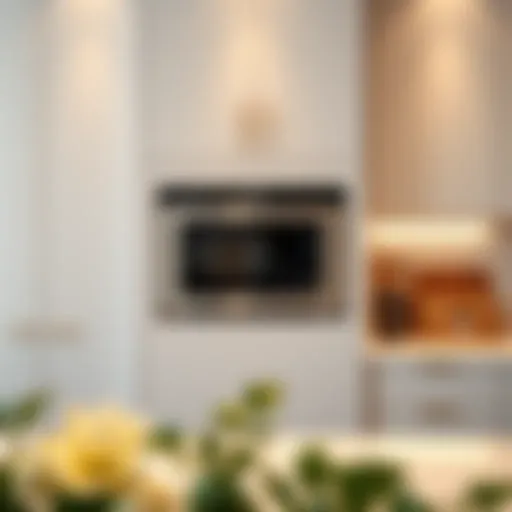The Complete Guide to Flat LED Wall Lights
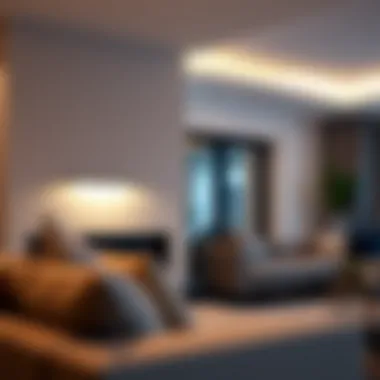
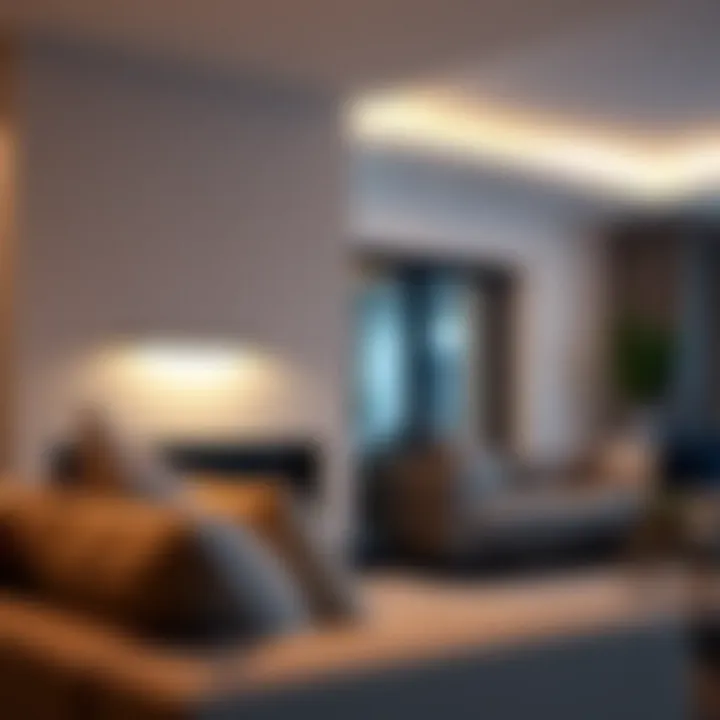
Intro
Flat LED wall lights have become a game-changer in interior lighting. Gone are the bulky fixtures of yesteryears, replaced by sleek and streamlined designs that complement contemporary decor. In this guide, we will navigate the world of flat LED wall lights, diving into their aesthetic flexibility, energy efficiency, and functional use in various spaces. Homeowners, designers, and DIY enthusiasts can gain valuable insights from exploring this innovative lighting solution.
The importance of lighting goes beyond mere illumination; it sets the mood, highlights architectural features, and contributes to the overall design scheme of a home. With advancements in technology, flat LED lights represent a significant step forward in enhancing interior aesthetics while saving energy.
It’s essential to understand how these fixtures fit within the ever-evolving trends in home decor. From living rooms to hallways, flat LED wall lights serve various functions, all while ensuring that each space shines bright in its unique way.
Foreword to Flat LED Wall Lights
Flat LED wall lights have become a crucial element in modern interior design, blending aesthetics with functionality. Not merely fixtures that light up a room, these lights hold the power to transform a space, set an ambiance, and even enhance the architecture of a wall. As society leans toward minimalism and efficiency, the importance of understanding these lighting solutions cannot be overstated.
Definition and Characteristics
Flat LED wall lights, as the name suggests, are lighting fixtures that are slim and flush-mounted against a wall. They are designed to occupy minimal space while providing an effective source of illumination. Typically, they employ light-emitting diodes (LEDs) to emit bright light while consuming less energy than traditional bulbs. One of the standout features is their low profile; they do not protrude much from the wall, making them ideal for tight spaces or where a sleek look is desired.
These fixtures often come in various shapes, sizes, and designs, which makes them suitable for different aesthetics—from ultra-modern to cozy traditional settings. The versatility is almost endless, with options available in a myriad of finishes like matte, glossy, or even metallic. An important characteristic worth mentioning is their ability to be integrated into smart home systems, allowing users to control the lighting environment conveniently via apps or voice commands.
Historical Context of Wall Lighting
To truly grasp the significance of flat LED wall lights, it’s beneficial to look back at the evolution of wall lighting as a whole. For centuries, wall lights served functional roles—think oil lamps and candles that illuminated homes with a warm, flickering glow. As electric lighting emerged in the late 19th century, it revolutionized the way people lit their spaces, especially in urban environments.
Fast forward to the late 20th century, and the introduction of fluorescent and halogen lights created new opportunities for designers and homeowners alike. However, as we became increasingly aware of energy consumption and its consequences, the industry began shifting focus towards more efficient options.
The modern flat LED wall light emerged as a response to the demand for energy efficiency and minimalistic design. This shift not only highlights technological advancements but also reflects changing tastes. Homeowners and designers are now prioritizing sustainability alongside beauty in their lighting choices.
"A room isn’t merely shaped by its walls, but by the light that fills it. Flat LED wall lights push the boundary of designing a space with intent."
In summary, understanding flat LED wall lights entails recognizing their definition and characteristics while also appreciating the rich history that illuminated them into existence. Whether for practical use or decorative purpose, these fixtures illustrate an ongoing dialogue between innovation, sustainability, and style, which is central to contemporary interior design.
The Evolution of LED Technology
The landscape of lighting has undergone a remarkable transformation over the years, with LED technology leading the charge into a future that prioritizes both energy efficiency and aesthetic flexibility. Understanding the evolution of LED technology is critical in grasping how we arrived at the sophisticated flat LED wall lights we have today.
How LEDs Work
LEDs, or Light Emitting Diodes, utilize a process known as electroluminescence to produce light. When an electric current passes through a semiconductor material, it excites electrons, which then release energy in the form of light photons. This mechanism stands in stark contrast to traditional incandescent bulbs, which generate light through heat, resulting in a significant waste of energy.
One fascinating aspect of LED technology is its scalability and adaptability. Modern LEDs are available in various colors and intensities, allowing designers to tailor lighting to specific moods or settings. For example, a warm white hue can create a cozy atmosphere in a living room, while a cooler daylight spectrum may be more suitable for workspaces. This versatility is a game changer not just for residential applications but commercial environments as well.
“LED technology has revolutionized the way we light our spaces, balancing efficiency with creativity.”
Advantages of LED Lighting
The advantages of LED lighting are manifold, making it a noteworthy contender in today’s lighting market. Here's why homeowners and designers are increasingly shifting towards LED solutions:
- Energy Efficiency: LEDs can convert up to 80% of their energy into light, compared to only about 10% for incandescent bulbs. This efficiency translates into lower electricity bills and a smaller carbon footprint.
- Longevity: With a lifespan that often exceeds 25,000 hours, LEDs dramatically reduce the need for frequent replacements, aligning well with sustainable practices.
- Low Heat Emission: LEDs emit very little heat, which can be an advantage in climate-sensitive settings or where heat buildup is a concern.
- Durability: Unlike traditional bulbs, LEDs are solid-state lights. This means they are more resistant to breakage, making them ideal for various applications, whether in homes or high-traffic commercial spaces.
- Dimming Capabilities and Smart Integration: Many modern LED lights allow for easy dimming, and they can be integrated with smart lighting systems. This feature not only enhances user experience but also contributes to energy savings.
Design Versatility of Flat LED Wall Lights
The design versatility of flat LED wall lights is paramount to their lore and value. These fixtures are not just sources of light; they are integral components of interior decor, capable of adapting to various styles and atmospheres. The charm of these lights lays in their ability to blend seamlessly into any space, be it modern, classic, or something in between. Their sleek profiles and low profile designs make them suitable for a variety of applications, deepening their appeal among consumers and designers alike.
Styles and Aesthetics
Modern Minimalism
Modern minimalism is all about simplicity and functionality. Flat LED wall lights that exemplify this style often feature clean lines, unadorned surfaces, and a focus on practicality. This aesthetic minimizes visual clutter and creates a serene environment, which is increasingly sought after in urban living spaces. A hallmark of modern minimalism in lighting design is the use of neutral or monochromatic colors, allowing fixtures to blend in or become understated focal points.
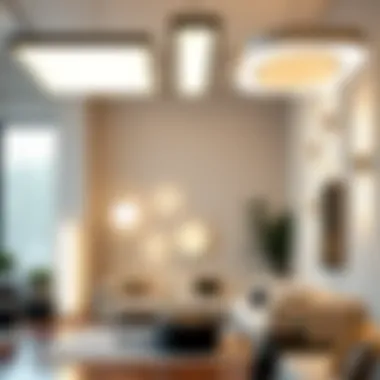

The unique quality of modern minimalist wall lights lies in their adaptability. Homeowners drawn to this design philosophy benefit from fixtures that suit various settings, transitioning from one use to another with ease. However, over-minimalism can sometimes create spaces that feel cold or uninviting. It’s essential to balance minimalist lighting with other elements that provide warmth and character.
Industrial Chic
On the flip side, industrial chic is gaining momentum, thanks to its bold, raw aesthetic that often embraces the beauty of imperfections. This style typically incorporates materials like unfinished metal, exposed bulbs, and visible hardware. Flat LED wall lights in this genre might echo the look of vintage factory lamps or incorporate wire frames that bring a touch of rugged authenticity to contemporary interiors.
A key advantage of industrial chic fixtures is their ability to add character to a room. They evoke a sense of history and charm, often appealing to those who appreciate the juxtaposition of old and new. However, this style could clash in more traditional or elegant environments, so consideration of the overall decor is necessary when selecting industrial elements.
Traditional Designs
Traditional designs exude timeless elegance and charm. Flat LED wall fixtures that embody this style might feature soft contours, classic finishes like bronze or antique white, and ornate detailing. The enduring appeal of traditional designs lies in their capacity to evoke nostalgia while providing modern functionality. This creates a bridge between the past and present in home decor.
A notable characteristic of these fixtures is the warmth they illuminate, enhancing the comfort of living spaces. They work exceptionally well in areas where intimate lighting is desired, like bedrooms or dining rooms. The downside, however, is that traditional designs could sometimes feel out of place in ultra-modern settings, requiring careful integration to avoid aesthetic dissonance.
Color Temperature and Ambiance
When it comes to flat LED wall lights, color temperature plays a critical role in shaping the mood of a space. The warmth or coolness of the light can dramatically alter the perception of a room. Typically measured in Kelvin, lower numbers (around 2700K) produce the soft glow reminiscent of incandescent bulbs, fostering a cozy atmosphere. In contrast, higher readings (4000K-5000K) yield a bright and vibrant light that is often more suitable for workspaces.
It's important for homeowners and designers to consider how the color temperature will interact with existing decor. Understanding the desired ambiance is crucial in choosing the right fixture. Here are a few considerations to keep in mind:
- Cohesiveness: Ensure that the color temperature aligns with the overall lighting scheme of the space.
- Functionality: Think about the purpose of the room; for example, warmer lights are often more relaxing for bedrooms, while cooler tones may enhance focus in offices.
- Layered Lighting: Utilizing multiple types of lighting can create depth and dimension in a room. Flat LED wall lights should complement, not compete with, other fixtures.
Remember: The right balance of color temperature and design style can set the stage for a stunning ambiance that reflects personal taste and enhances the overall aesthetic of a space.
Practical Applications in Interior Design
Flat LED wall lights have come a long way in enriching various spaces, serving as both functional and artistic elements in interior design. These fixtures offer a blend of practicality and style, making them a go-to choice for homeowners, designers, and anyone looking to enhance their environment. Understanding their practical applications is vital because these lights not only illuminate but also shape how a space feels and functions. The right lighting can turn an ordinary room into an inviting haven or a bustling workspace into an inspiring area.
Living Room Lighting Strategies
When it comes to living rooms, the choices for lighting are vast, but flat LED wall lights stand out for a few key reasons. They can create an ambient glow that softens the harsher light from overhead fixtures, adding layers of illumination that enhance comfort. Consider a scenario where soft white light creates a calm setting, perfect for relaxation at the end of a long day. Alternatively, vibrant color temperatures can invigorate the space, making it ideal for gatherings.
In practice, a combination of these lights arranged strategically on the wall can spotlight artwork or architectural features, adding depth and character to the living room. A few effective strategies include:
- Layering light: Using flat LED wall lights alongside floor lamps and table lamps can achieve a balanced look.
- Focal points: Directing light toward paintings or unique decor draws attention to these elements, making them stand out.
- Zoning space: Placing fixtures at different heights can help delineate areas within an open concept living space, providing structure without the need for physical barriers.
Enhancing Bedrooms with Wall Fixtures
In the realm of bedroom design, mood lighting plays a crucial role in fostering a restful atmosphere conducive to sleep. Flat LED wall lights can fulfill this role beautifully. Their adaptability means they can be used for reading lights, ambient lighting, or even accent lights that celebrate personal mementos.
For example, having a wall-mounted flat LED light above the headboard can serve the dual purpose of providing direct light for reading without taking up valuable nightstand real estate. Moreover, adjustable models can let users shift the light direction as needed, enhancing functionality.
It's also worth mentioning that the color temperature can significantly impact the room's feel. Warmer tones often promote relaxation, making them perfect for this intimate space. Here are some ways to make the most out of these fixtures:
- Sconce placement: Positioning fixtures at eye level ensures light isn't overwhelming during the late-night read.
- Dimmer controls: Incorporating dimmers allows for personalized lighting settings, facilitating a smooth transition from a bright environment to a cozy one.
- Thematic integration: Choosing designs that align with the overall bedroom theme, whether minimalist or bohemian, adds coherence and elegance.
Utilizing Light in Commercial Spaces
Flat LED wall lights are not just for homes; they play an important role in commercial settings, where efficient and stylish lighting can influence customers and employees alike. In retail environments, the correct lighting can lead to increased sales and customer satisfaction. Think about a boutique where the emphasis is on showcasing the products. Properly positioned wall lights can highlight merchandise, setting the mood and directing attention where it needs to go.
In office spaces, these lights can help create dynamic work environments. They can be used in collaborative areas to stimulate creativity while also providing focused lighting in quiet zones enhancing productivity. Consider these applications:
- Retail display: Using flat LED wall lights to illuminate product displays without creating glare.
- Conference rooms: Implementing adjustable wall lights that can switch between ambient lighting for meetings and focused lighting for presentations.
- Hospitality: Hotels and restaurants benefit from these fixtures by creating inviting entryways and coziness in dining areas, influencing overall guest experience.
"Effective lighting design can transform not just a space but also the experiences within it."
In sum, flat LED wall lights serve crucial functions in both residential and commercial interiors, blending practicality with aesthetics seamlessly. Their varied applications reinforce the concept that good lighting design is integral to enhancing any space.
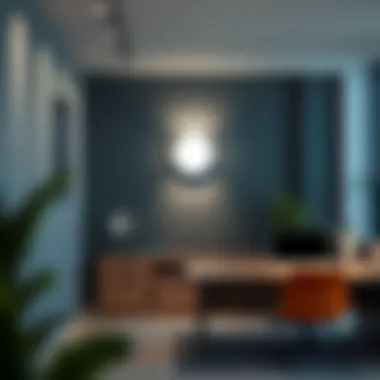

Energy Efficiency and Sustainability
In the modern landscape of interior design, energy efficiency paired with sustainability has moved from being a buzzword to a critical standard for lighting solutions, particularly for flat LED wall lights. These fixtures not only elevate the aesthetic of a space but also play a significant role in reducing energy consumption and promoting environmental stewardship. With advancements in technology, the ability to strike a balance between beautiful design and eco-conscious choices is increasingly achievable.
Comparative Energy Usage
Let’s take a closer look at energy usage among different lighting options. Traditional incandescent bulbs consume an excessive amount of energy, often leading to inflated electricity costs and a smaller lifespan. In contrast, flat LED wall lights are renowned for their efficiency.
- LEDs consume up to 75% less energy than their incandescent counterparts.
- They have an operational lifespan of nearly 25,000 hours or more, whereas incandescent bulbs last about 1,000 hours.
- This means fewer replacements and less waste, highlighting not just energy savings but also a commitment to reducing black litter.
Investing in flat LED wall lights means making a wise choice for both your wallet and the planet. Understanding the metrics at play can help homeowners and designers make informed decisions about their lighting choices.
Impact on Electricity Bills
The financial aspect of adopting energy-efficient lighting cannot be overstated. Installing flat LED wall lights can lead to impressive reductions in electricity bills. For instance, using a single LED fixture can save a household significant amounts every year compared to traditional lighting.
- Consider an LED light averaging about 10 watts compared to a 60-watt incandescent. If used for five hours a day, that could mean:
- LED: 10W x 5 hours x 30 days = 1.5 kWh/month
- Incandescent: 60W x 5 hours x 30 days = 9 kWh/month
This stark contrast can translate to a savings of several dollars each month, proving that energy-efficient lighting is not just about reducing carbon footprints; it's also about saving pennies.
"By making simple lighting changes, households can cut their bills while contributing to a greener future."
Sustainable Manufacturing Practices
The path towards sustainability extends beyond the consumer's choice; it starts at the manufacturing stage as well. The production of flat LED wall lights embraces various sustainable practices that minimize environmental impact. Manufacturers are increasingly focusing on:
- Using recyclable materials for housing and components.
- Reducing harmful substances in the manufacturing process to comply with regulations like RoHS (Restriction of Hazardous Substances).
- Implementing energy-efficient production techniques to lower overall carbon emissions.
When considering the larger picture, selecting flat LED wall lights aligns with a commitment to sustainability not just from the user's end but across the supply chain. By choosing these fixtures made with care, consumers contribute to a sustainable ecosystem where energy efficiency meets responsible manufacturing.
Installation Guidelines
Installing flat LED wall lights goes beyond mere placement; it's a pivotal aspect that affects their functionality, aesthetics, and safety. A well-executed installation can enhance the lighting performance and ultimately affect how a space feels and functions. From illuminating cozy corners in your living room to creating inviting atmospheres in commercial spaces, precise installation is essential for achieving the desired ambiance.
Preparation and Planning
Preparation isn’t just about gathering tools; it sets the tone for the entire installation process. Start by assessing the space where you intend to install your flat LED wall lights. Consider the room’s purpose, the existing light sources, and how much illumination you require.
- Measure Your Space: Use a measuring tape to calculate wall dimensions and the optimal height for your fixtures. This not only helps in functionality but in achieving a balanced look.
- Choose the Right Fixtures: The selection depends on the room’s style, size, and lighting needs. Ensure the style complements your existing decor while also meeting practical demands.
- Plan the Wiring Path: Identify where you will run the electrical wiring. Cutting too many corners here might lead to problems down the line. Assess if a professional electrician is warranted for more complex setups.
The goal here is to create a blueprint that accounts for all possible contingencies, which eases the installation process later on.
Wiring and Electrical Considerations
Wiring flat LED wall lights requires careful assessment to prevent electrical issues. Safety should always come first. Here's what to take into account:
- Check Local Code Requirements: Familiarize yourself with the local electrical codes. Regulations can vary, and it’s crucial to comply to avoid fines and ensure safety.
- Select Appropriate Wiring: Depending on the wattage and number of fixtures you plan to install, choose suitable wire gauge. Generally, 14-gauge wire is sufficient for most LED applications.
- Knockout and Junction Boxes: Verify clear access to knockout holes and junction boxes. If your existing setup doesn't match the new design, you may need to create new openings.
When wiring, turn off the power supply at the circuit breaker. As mundane as it sounds, this step could save you from potential hazards.
Placement and Height Recommendations
Where you place your flat LED wall lights significantly influences their effectiveness. Here are a few vital guidelines:
- Optimal Height: Mount fixtures at eye level, typically around 60 inches from the floor. This height effectively creates ambient lighting without being blinding or obtrusive.
- Spacing Between Fixtures: Depending on the brightness and purpose, aim for 5 to 10 feet between fixtures for an even spread of light. This ensures you don't create hotspots or dark areas.
- Consider Functionality: Place lights strategically to enhance the function of the room. For example, install lights in hallways or near artwork to guide or highlight spaces.
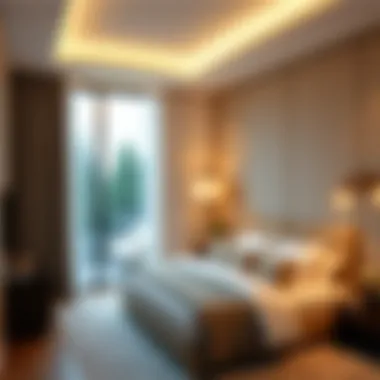
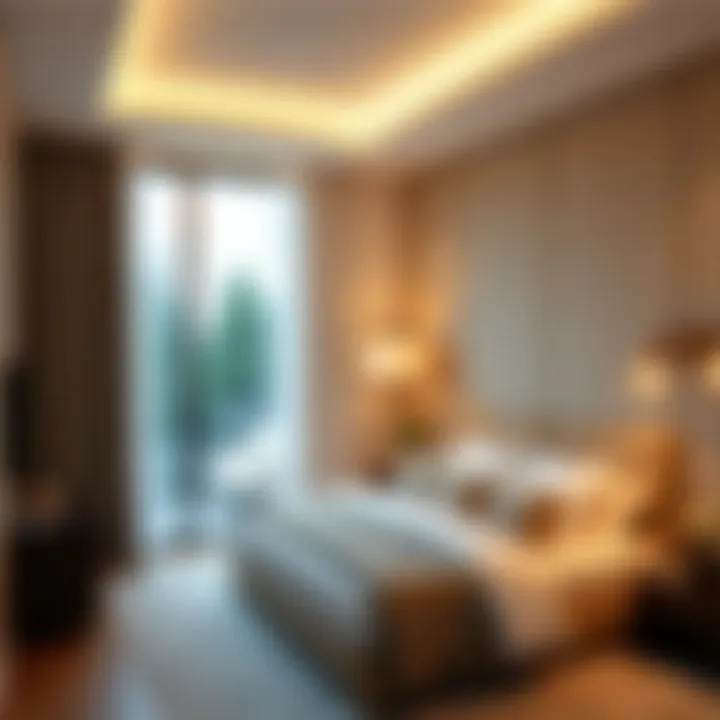
In essence, a thoughtful examination of placement can transform a simple wall light into a functional centerpiece that elevates the overall decor.
Maintenance and Care
Maintenance and care of flat LED wall lights is crucial for keeping them functional and ensuring they last longer. Despite the benefits of longevity and energy efficiency these lights bring, like all electrical fixtures, they require some attention now and then. Neglect can lead to reduced performance and, in the worst case, faulty or dim lighting. Proper care not only extends the lifespan of the fixtures drastically, but it also preserves the aesthetic appeal they bring to any environment.
Cleaning Techniques for Longevity
Cleaning your flat LED wall lights should be part of your seasonal upkeep. Dust and grime can accumulate over time, dulling the light output and tarnishing the elegance of the fixture. Here’s how to keep your lights gleaming:
- Turn OFF the Power: Always make sure the fixture is not powered before you start cleaning. Safety first!
- Soft Cloth Wipe: Use a soft, dry cloth to dust off light surfaces. Microfiber is a great choice as it traps dust without scratching surfaces.
- Gentle Cleaners: For tougher stains, a damp cloth with mild soap or glass cleaner may be utilized. Just ensure that water doesn’t seep into any electrical components.
- Avoid Chemicals: Harsh chemicals can damage the finish of your light. Stick to gentle solutions meant for delicate cleanings.
- Inspect Regularly: As you clean, take a moment to inspect the fixture for any signs of wear or loose connections. Early detection can prevent bigger issues later.
"A clean light fixture not only serves its purpose but adds beauty to a room."
Troubleshooting Common Issues
Understanding common problems with flat LED wall lights can help you resolve issues quickly without the need to call professionals. Here are some typical issues:
- Flickering Lights: This can be caused by loose wiring or an incompatible dimmer switch. Check all connections and replace the dimmer if necessary.
- Dimming or No Light: The LED may be on the fritz. It might be time to swap it out. Sometimes, simply tightening the bulbs will fix the issue if they’re loose.
- Color Discrepancies: If your lights start to emit an unexpected hue, it could indicate a problem with the driver or power supply. Look into replacing them or consult with a professional if uncertain.
- Overheating: If the fixtures feel excessively hot, it could point to a problem. Switch them off to cool down and check the installation. Adequate ventilation is key in preventing heat build-up.
With a little effort in maintenance and troubleshooting, your flat LED wall lights can remain standout features in your home or workspace. Staying ahead of potential issues and keeping them clean ensures your lighting continues to shine bright, creating the perfect ambiance.
Trends and Innovations in Lighting Design
In the rapidly evolving world of interior design, trends and innovations in lighting are crucial for creating spaces that not only function well but also inspire and invoke emotion. Flat LED wall lights stand at the forefront of this evolution, serving various aesthetic and practical needs. From smart technology to nature-inspired designs, these innovations do more than illuminate; they transform the very essence of a room.
Smart Lighting Integration
The integration of smart technology into flat LED wall lights is reshaping how we interact with these fixtures. Homeowners can now customize their lighting experiences with just a few taps on a smartphone or voice commands. Features like app control, scheduling, and even geofencing allow users to program their lights to adjust according to time of day or activity. For instance, your living room can transition from bright white light during the day to a warm glow in the evening without lifting a finger.
Benefits of smart lighting include:
- Energy Efficiency: Smart lights often come with energy-saving modes. By turning off lights automatically when no one is in the room, they help lower electricity bills.
- Customization: Users can choose specific colors and brightness levels, enabling them to create tailored ambiances for different occasions.
- Integration with Smart Home Systems: Many LED wall lights can work in harmony with other smart devices, such as thermostats and security systems, enhancing the overall efficiency and security of a home.
This technological leap does come with considerations. Homeowners must ensure a reliable Wi-Fi connection and explore compatibility with existing smart home setups, which can occasionally limit choices. Despite these challenges, the convenience and flexibility provided by smart lighting cannot be overstated.
Biophilic Design Principles
Biophilic design principles unfold the relationship between natural settings and well-being, and incorporating these philosophies into lighting design can enhance the overall atmosphere. Using flat LED wall lights that mimic natural light patterns is crucial for interiors aiming for a more organic aesthetic. Think of it as capturing the soft essence of daylight and integrating that into a home’s design.
This approach can be particularly effective in indoor environments, where exposure to natural light is limited. Here are a few key approaches:
- Color Temperature: Utilizing lights that replicate the color temperatures of natural light helps regulate circadian rhythms, making spaces more comfortable and aligned with human biology.
- Natural Materials: Combining flat LED fixtures with natural materials, such as wood or stone, creates a seamless transition from artificial light to natural elements, fostering a sense of tranquility.
- Focus on Views: Positioning flat wall lights to illuminate greenery or outdoor views can draw the eye and create an integrated feel between indoor and outdoor spaces, enhancing both aesthetics and mental well-being.
"Integration of nature into habitations is not just a trend; it's a lifestyle adjustment that pays dividends in comfort and relaxation." Thus, those who embrace biophilic design can expect to see improvements in mood and well-being, all while finding creative, engaging ways to light their interiors.
Finale and Future Outlook
The exploration of flat LED wall lights highlights their significance not just as functional fixtures, but as essential components of modern interior design. It’s clear that these lights have carved out a vital niche in both residential and commercial spaces. Their blend of energy efficiency and aesthetic appeal not only enhances living and working environments but also addresses growing concerns for sustainability.
The Ongoing Relevance of Flat LED Wall Lights
Flat LED wall lights have maintained their place in contemporary decor for several reasons. For starters, their streamlined design offers versatility that can fit seamlessly into various decor styles. Whether it’s sleek, modern homes or classic interiors, these lights adapt beautifully. One cannot underestimate their role in enhancing the visual comfort of a space. For example, strategically placed wall lights create depth and interest without taking up floor space, thereby maximizing functionality in tight areas.
Moreover, as more people lean towards eco-conscious choices, flat LED wall lights serve as a practical solution. The reduction in energy consumption translates not just to lower electrical expenses, but also contributes positively to a reduction in a home’s carbon footprint. An investment in these lights can yield significant long-term benefits—both financially and environmentally.
Predictions for Market Trends
Looking forward, several trends are poised to shape the market for flat LED wall lights:
- Smart Lighting Integration: With the rise of smart home technology, flat LED wall lights are likely to integrate more with home automation systems. This means homeowners can control their lighting through mobile apps or voice commands.
- Sustainable Materials: As the conversation around sustainability continues to grow, manufacturers may start using more eco-friendly materials in constructing these lights. This could range from recycled metals to bio-based plastics, appealing to an increasingly eco-conscious consumer base.
- Customization Options: Personalization is key in many aspects of design today. The demand for customizable light fixtures is likely to rise. Consumers might seek tailored wattage options or the ability to choose different color temperatures or finishes that align with their individual style.
- Health-Conscious Lighting: There's a growing awareness of how lighting affects mental and physical health. Future designs might focus more on circadian-friendly options that promote well-being.
“In lighting, as with many things, one size certainly doesn’t fit all. The future lies in customization and innovation.”
For further insights into lighting design and trends, visit resources like Wikipedia on LED lighting or explore discussions on Reddit about interior lighting for community expertise.











